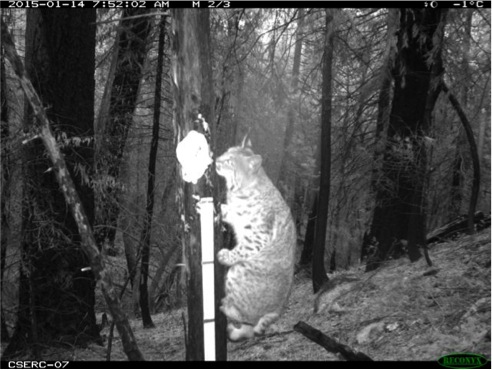For two decades CSERC staff has set up photo-detection camera stations to get photo evidence of elusive, rare animals. Over years of work done in cooperation with Yosemite Park and Stanislaus Forest biologists, our staff has become spoiled with excellent results. We shrug off pictures of mother bears with cubs, squirrels and chipmunks, snowshoe hares, deer, and common birds. Even ringtail cats, mountain lions, and bobcats only generate short-term excitement. The rare species we seek are the more elusive furbearers such as the American marten, the Pacific fisher, the Sierra Nevada red fox, and the wolverine. Once again this winter we’ve been setting up and maintaining cameras in Yosemite Park. But the results have been highly puzzling. With sets of four baited cameras functioning fulltime since early January, we have been surprised that many sites had no animals at all attracted to the bait between weekly checks. Peanut butter, peanut rings, and “chicken in a sock” prompted no visits from hungry species. At one camera, not a single animal came in the entire month. Each week’s fresh bait went untouched despite pungent attractant scents that can draw in animals from long distances. Over two decades of CSERC doing wildlife photo surveys, we have never had so few species visit the bait. What are possible reasons for the unusual lack of wildlife? First, many sites we’ve surveyed in the Park have been located in moderate to high severity burn areas within the Rim Fire. They had few groundcovers, bushes, or other food or shelter — only lots of snags amidst scattered surviving trees. The habitat was clearly deficient. A second possible reason is the drought. After four dry years, there is less vegetation to benefit prey that then benefits predators. Prey species that form the base of the food chain were notably absent. With four cameras baited, only two squirrels were detected over a month. In mid-March, the first family of bears emerged to devour the bait at one station. In the photo above, a bobcat was photographed as it squatted precariously on a slender branch to sniff the chicken bait in the sock. But overall the effects of fire and drought appear to have markedly reduced wildlife diversity and wildlife numbers. Now that our staff has shifted to unburned areas for two of our new sites, we expect more animals to pose for their picture. If results are still abnormally low, even at unburned sites, then drought will be even more likely to be the key factor.


